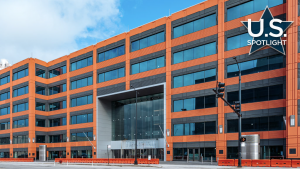Cement and concrete production has one of the largest carbon footprints of any industrial sector on the planet.
Production volumes are anticipated to remain stable for at least the next three decades.
The global concrete industry has not been idle in its pursuit towards a greener product. The Global Cement and Concrete Association has targeted a 20 per cent reduction of CO2 per metric ton of cement and a 25 per cent reduction of CO2 per cubic metre of concrete by 2030 compared to 2020 levels, with complete decarbonization by 2050.
Transitioning away from fossil-fuelled production towards electricity from renewable sources and underground carbon storage in clinker production have also been discussed and considered as possible pathways.
However, McKinsey Global estimates reaching net-zero emissions by 2050 would require an average annual capital expenditure of $60 billion from 2021 to 2050.
“These costs, as well as the costs to develop novel decarbonization technologies and processes, have made industry players cautious about adopting many newer innovations.”
There are alternatives not as expensive as rebuilding the entire concrete production infrastructure.
Carbon capture and utilization processes like Canada’s own CarbonCure Technologies have gained popularity. Traditional supplementary cementitious materials such as fly ash, ground granulated blast-furnace slag and silica fume are being used as partial substitutes for clinker used in cement, or the cement content of concrete.
The drive for innovative solutions is ongoing. One approach is to use novel materials as additives that can both increase strength to concrete while reducing carbons associated with traditional processes.
According to McKinsey’s analysis, “admixtures have the potential to reduce CO2 emissions in concrete by up to 30 per cent under current standards and up to 50 per cent under updated standards.”
California-based C-Crete Technologies, in conjunction with Heidelberg Materials, poured 60 tons of its cement-free concrete as part of the seismic and energy retrofit of a historic building in Seattle. In place of Portland cement, the concrete used environmentally safe materials that can be locally sourced and converted to a cementious binder.
“Each ton of C-Crete binder that replaces Portland cement prevents approximately one ton of CO2 emissions,” the company said in its media release. “Furthermore, the product utilizes a suite of natural minerals and industrial byproducts, ensuring an abundant feedstock.”
The company added the loading strength per square inch exceeded the ASTM standard for most residential, commercial and infrastructure concrete applications by 25 per cent, while meeting other industry standards for durability, such as resistance to freeze-thaw cycles, alkali-silica reactions and chloride and acid penetrations. C-Crete is also compatible with conventional concrete admixtures, allowing for easy integration into existing construction practices.
Further development of C-Crete has been boosted by a $2 million grant from the U.S. Department of Energy.
Using recycled materials as an additive to concrete is also being explored.
Global real estate developer Lendlease JV began construction this past spring on an 834-unit residential project in Brooklyn, N.Y., which it says will be one of the largest geothermal residential buildings in the U.S.
Notably, 40 per cent of the Portland cement in the building’s foundation will be replaced with recycled ground glass pozzolan, using glass waste that otherwise might end up in landfills.
Pozzolans are siliceous or siliceous and aluminous materials that, when finely ground, chemically react with calcium hydroxide in the presence of water to form compounds that have cementitious properties.
Other recycled additives are being developed to make concrete stronger.
In a somewhat ironic twist, glass fibre wind turbine blades could find new purpose as reinforcement in concrete when retired at the end of their 20-year lifespan.
Iowa-based start-up Regan Fiber has developed a patent-pending process that shreds the blades into fibre additives that increase the strength and durability of pavement and precast concrete components. A dedicated manufacturing plant is planned, with an expected annual output of 30,000 tons of shredded fibre.
Waste plastics, particularly those difficult to recycle, are being transformed into a fine aggregate through a thermal and chemical process called RESIN8, developed by CRDC Global, that adds strength, fire resistance and insulating properties while at the same reducing weight.
“RESIN8 has a positive impact on both the plastics and the construction industries as a functional example of zero waste,” said Donald Thomson, CEO of CRDC Global.
In June, CRDC Global announced the construction of a RESIN8 conversion plant in Australia, following up on its first U.S. plant in Pennsylvania last October. The company has announced a number of contract signings, including a supply agreement to introduce concrete blocks using RESIN8 into the Mexican construction market.
McKinsey says the various pathways towards greener concrete will be in competition for investment and will be adopted at different rates depending on the specific market. Cost, regulations and design specifications will also influence the rate of global concrete decarbonization.











Use of pozzolanic cement is vital to reduce carbon emissions.